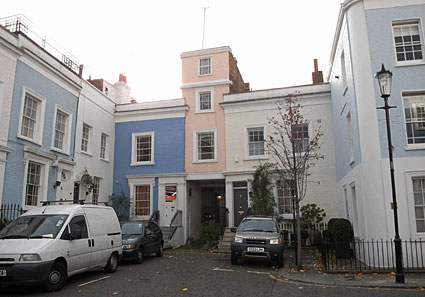|
A Walk To Holland Park
Late Autumn city walk around Notting Hill (Part 1 - Part 2)
(Photos/words © urban75, 10th November, 2007)
Cursed with a thumping hangover after a big night in Brixton, I decided to head west to the upmarket cosmopolitan district of Notting Hill.
Known as 'Knottynghull' in 1356 and notching up such variants as 'Knotting-Bernes,' 'Knutting-Barnes' and 'Nutting-barns' over the centuries, the area remained rural until the the early 19th century.
The Ladbroke family, the main landowner in the area, started to develop the village into a fashionable suburb from the 1820s, with many large houses lining the streets.
A slow decline saw parts of Notting Hill being described by Salvation Army founder Charles Booth as, 'one of the worst areas in London' by 1903.
The slums were cleared during redevelopment in the 1960s and '70s, and since then many well heeled families have returned to make the Notting Hill one of London's most desirable areas.
For many, Notting Hill is perhaps best known for its yearly Carnival, the nearby Portobello Road market and the race riots of 1958.

Looking east along Holland Park Avenue towards Notting Hill Gate.

Hillgate Street.

The Grade II listed 1898 Coronet Cinema, formerly a theatre.

The area just south of Notting Hill Gate is full of very attractive Georgian/early Victorian terraced houses which, no doubt, cost a bomb.




A threatening sky looms behind the brightly coloured terraced houses.


Railings and lamps.


Victorian cottages with period iron work on Holland Park Avenue.


Statue of St Volodymyr, ruler of Ukraine 980-1015, by Holland Walk.

Ornate entrance to the Cardinal Vaughan Memorial School, a Roman Catholic voluntary-aided comprehensive school on Addison Road.

Stunning, turquoise-blue tiled building facing Addison Road.



St Baranabas Church, one of Kensington's oldest church buildings.
Constructed in 1828, the building features four corner turrets and Perpendicular tracery.

Detail of the striking frontage Marcus Stone's house at 8 Melbury Road, Holland Park, built by
R. Norman Shaw in 1875-76.

Further along Melbury Road is Tower House, designed by William Burges as his own house and based on Castell Coch, near Cardiff, which he designed for the 3rd Marquis of Bute.
Dominating the front is a circular tower which houses the internal staircase. The house was built by Ashby Brothers of Kingsland Road between 1875 and 1877.


|

